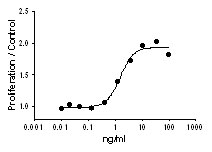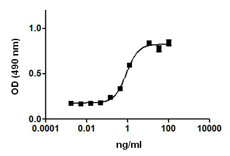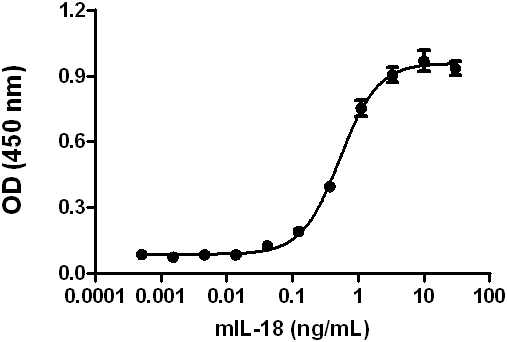- Regulatory Status
- RUO
- Other Names
- IL-15
- Ave. Rating
- Submit a Review
- Product Citations
- publications

-

Mouse IL-15 induces the proliferation of CTLL2 mouse cells. The ED50 for this effect is 2.5 – 15 ng/mL. -

Mouse IL-15 induces the proliferation of HT-2 cells. The ED50 for this effect is 0.2 - 1.4 ng/mL.
This product is not available for shipping outside of the United States.
IL-15 was discovered in the supernatant of Simian kidney epithelial cell line CV-1/EBNA, as a soluble factor capable of supporting proliferation of the IL-2-dependent cell line, CTLL-2. IL-15 is a regulatory cytokine, and it is produced by dendritic cells, epithelial cells, fibroblasts, and monocytes. IL-15 plays an important role in immune response and shares many functions with IL-2. For example, it stimulates the proliferation of activated T cells, NK cells, and B cells, and induces immunoglobulin synthesis by B cells stimulated by anti-IgM or CD40 ligand. In addition, IL-15 promotes the development of dendritic cells and induces the production of proinflammatory cytokines from macrophages. IL-15 acts as a bridge between innate and adaptive immunity because of its diverse roles in the immune system.
IL-15 binds to heterotrimeric receptors composed of IL-15Rα, IL-15Rβ, and IL-15Rγc. IL-15 shares the receptor chains β and γc with IL-2. IL-15 is normally not secreted in soluble form but is instead held on the cell surface bound to a unique receptor, IL-15Rα, especially on dendritic cells. Cell-bound IL-15 is then presented in trans form to T cells and NK cells and is recognized by the γc receptor on these cells; such recognition maintains cell survival and intermittent proliferation.
Product DetailsProduct Details
- Source
- Mouse IL-15, amino acids Asn49-Ser162 (Accession# NM_008357), was expressed in E. coli.
- Molecular Mass
- The 115 amino acid N-terminal methionylated recombinant protein has a predicted molecular mass of 13,382 Da.
- Purity
- Purity is >95%, as determined by Coomassie stained SDS-PAGE.
- Formulation
- Lyophilized from a concentrated solution (1 mg/ml) with 10 mM NaH2PO4, 150 mM NaCL, pH 8.0.
- Endotoxin Level
- Less than 1 EU/µg cytokine as determined by the LAL method.
- Preparation
- For maximum results, quick spin vial prior to opening. Reconstitute in sterile water to a concentration of 0.1 mg/ml including a carrier protein such as 1% BSA or HSA or 10% FBS.
- Storage & Handling
- Unopened vial can be stored between 2°C and 8°C for one month, at -20°C for six months, or at -70°C for one year. For maximum results, quick spin vial prior to opening. The protein can be aliquoted and stored from -20°C to -70°C. Stock solutions can also be prepared at 50-100 µg/mL in sterile buffer (PBS, HPBS, DPBS, or EBSS) containing carrier protein such as 0.2-1% BSA or HSA and stored in working aliquots at -20°C to -70°C. Avoid repeated freeze/thaw cycles.
- Activity
-
Mouse IL-15 induces the proliferation of CTLL2 mouse cells. The ED50 for this effect is 2.5 – 15 ng/mL.
Mouse IL-15 induces the proliferation of HT-2 cells. The ED50 for this effect is 0.2 - 1.4 ng/mL. - Application
-
Bioassay
- Application Notes
-
This IL-15 protein is biologically active and can be used for in vitro assays.
- Product Citations
-
Antigen Details
- Structure
- Cytokine
- Distribution
-
IL-15 is expressed by DC, epithelial cells, fibroblasts, and monocytes.
- Function
- IL-15 stimulates the proliferation of activated T cells, NK cells, and B cells, and inducing immunoglobulin synthesis by B cells stimulated by anti-IgM or CD40 ligand. In addition, IL-15 promotes the development of dendritic cells, and induces the production of proinflammatory cytokines from macrophages.
- Ligand/Receptor
- IL-15Rα, IL-15Rβ and IL-15γc
- Cell Type
- Hematopoietic stem and progenitors
- Biology Area
- Immunology, Innate Immunity, Stem Cells
- Molecular Family
- Cytokines/Chemokines
- Antigen References
-
1. Grabstein K, et al. 1994. Science 264:965.
2. Ma A, et al. 2006. Annu. Rev. Immunol. 24:657.
3. Meresse B, et al. 2004. Immunity 21:357.
4. Armitage RJ, et al. 1995. J. Immunol. 154:483.
5. Pulendran B, et al. 2004. Eur. J. Immunol. 34:66.
6. Bouchard A, et al. 2004. J. Leukoc. Biol. 76:162.
7. Ratthe C, et al. 2004. J. Leukoc. Biol. 75:893.
8. Feng T, et al. 2008. Cell. Immunol. 5:189.
9. Rubinstein MP, et al. 2006. P. Natl. Acad. Sci. USA 103:9166. - Gene ID
- 16168 View all products for this Gene ID
- UniProt
- View information about IL-15 on UniProt.org
Related FAQs
- Why choose BioLegend recombinant proteins?
-
• Each lot of product is quality-tested for bioactivity as indicated on the data sheet.
• Greater than 95% Purity or higher, tested on every lot of product.
• 100% Satisfaction Guarantee for quality performance, stability, and consistency.
• Ready-to-use liquid format saves time and reduces challenges associated with reconstitution.
• Bulk and customization available. Contact us.
• Learn more about our Recombinant Proteins. - How does the activity of your recombinant proteins compare to competitors?
-
We quality control each and every lot of recombinant protein. Not only do we check its bioactivity, but we also compare it against other commercially available recombinant proteins. We make sure each recombinant protein’s activity is at least as good as or better than the competition’s. In order to provide you with the best possible product, we ensure that our testing process is rigorous and thorough. If you’re curious and eager to make the switch to BioLegend recombinants, contact your sales representative today!
- What is the specific activity or ED50 of my recombinant protein?
-
The specific activity range of the protein is indicated on the product datasheets. Because the exact activity values on a per unit basis can largely fluctuate depending on a number of factors, including the nature of the assay, cell density, age of cells/passage number, culture media used, and end user technique, the specific activity is best defined as a range and we guarantee the specific activity of all our lots will be within the range indicated on the datasheet. Please note this only applies to recombinants labeled for use in bioassays. ELISA standard recombinant proteins are not recommended for bioassay usage as they are not tested for these applications.
- Have your recombinants been tested for stability?
-
Our testing shows that the recombinant proteins are able to withstand room temperature for a week without losing activity. In addition the recombinant proteins were also found to withstand four cycles of freeze and thaw without losing activity.
- Does specific activity of a recombinant protein vary between lots?
-
Specific activity will vary for each lot and for the type of experiment that is done to validate it, but all passed lots will have activity within the established ED50 range for the product and we guarantee that our products will have lot-to-lot consistency. Please conduct an experiment-specific validation to find the optimal ED50 for your system.
- How do you convert activity as an ED50 in ng/ml to a specific activity in Units/mg?
-
Use formula Specific activity (Units/mg) = 10^6/ ED50 (ng/mL)
 Login / Register
Login / Register 














Follow Us